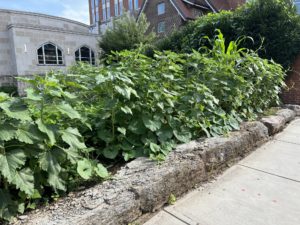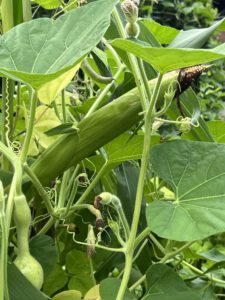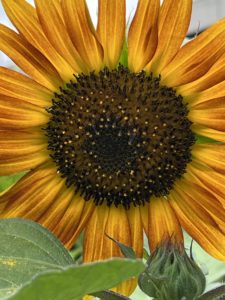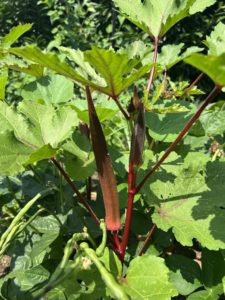
Figure 1. Our Southern Foodways Garden behind Strong Hall on the UTK campus – corn peaks above the greenery in the back right while sunflowers and bottle gourd vines flank the stony ledge.
With our garden in full glory, we couldn’t pick just one Plant of the Month! Earlier this year, we started a Southern Foodways Garden in a bed adjacent to the Cottage behind Strong Hall on the north end of campus.
When we think of southern food, what comes to mind are cornbread, grits, barbecue, fried green tomatoes, fried okra… ingredients and techniques that we owe to Native Americans and enslaved Africans from the South’s colonial past. We teach about these plants in the classroom and present them in displays at the Museum, but photos and dioramas do little justice to the vibrant energy of a living garden!

Figure 2. Can you find the ear of corn, the green bean pod, and the growing bottle gourd in this photo?
We focus on two sets of plants during this inaugural season of our garden. The first set centers on plants domesticated by Native Americans, particularly the familiar “Three Sisters’ Garden” of corn, beans, and squash. However, we replaced squash with bottle gourd, as we wanted to limit the amount of food produced since we are not certain about what chemical inputs may inadvertently drift into our campus garden. Bottle gourds are the oldest domesticated crop in the Americas, dating at least 10,000 years ago. Squashes are a close cousin, domesticated around 5000 years ago by groups living in the Eastern Woodlands of North America. These groups also domesticated sunflowers – the oldest known domesticated sunflower seed comes from an archaeological site in central Tennessee, dating 4200 years ago! The farming peoples in our region added corn to their food plots around 1000 years, and beans around 700 years ago, both of which were passed along routes that connected all the way down to Mesoamerica.

Figure 3. A few of our sunflowers have started to bloom.
The second set of plants highlight some of the crops that Africans brought with them on their forced journey into slavery in the Americas. They tucked seeds of okra and black-eyed peas (or cowpeas), among other grains like rice, into the lining of their pockets or into their hair. They may have also brought bottle gourds with them, which groups in Africa also domesticated at least 4000 years ago. Or they may have been relieved to see bottle gourds growing locally when they arrived in the Americas. Africans and Native Americans used bottle gourds for a wide range of purposes, from containers to fishing floats to musical instruments.

Figure 4. Burgundy okra pods are skirted by black-eyed pea pods.
The garden is not haphazard, but it’s certainly not orderly: the beans and black-eyed peas climb up the corn stalks and okra and sunflower stems for support. Meanwhile, the bottle gourd vines meander at will among the others, shading the dirt to keep in moisture and outcompete weeds for sunlight. After several weeks of regular rain showers, the gourd vines are nearly riotous and threatening to take over the whole patch!
We have learned a lot from the garden already – about the timing of plantings, sunlight requirements, responsiveness to rain, reduction in weeds over the course of the season as leaves and vines spread, timing of ripened pods… And we will continue to learn more about harvesting and preparing seeds and kernels and gourds for storage into the fall. We aim to share the seeds and gourds with students of all ages through programs at the Museum and the University.
In the meantime, if you find yourself near the corner of Cumberland Avenue and 16th Street, come by and check out our Southern Foodways Garden and its cacophony of vines, leaves, flowers, and fruits! Or share pictures of your garden with us. Better yet, share your stories about southern foods and the people you share them with.
For more information:
Check out our previous Plant of the Month posts on sunflowers, beans, and okra, as well as the following websites.
“How to Grow a Three Sisters Garden” by Melissa Kruse-Peeples. Native Seeds Search, https://www.nativeseeds.org/blogs/blog-news/how-to-grow-a-three-sisters-garden (2016).
“Rice Reveals Enslaved Africans’ Agricultural Heritage” by Virginia Gewin. Sapiens, https://www.sapiens.org/culture/african-rice-new-world/ (2017).
“Seeds of Memory: Botanical Legacies of the African Diaspora” by Judith Carney. In African Ethnobotany in the Americas, edited by R. Voeks and J. Rashford, pp. 13-33. Springer Science+Business, New York. https://www.geog.psu.edu/sites/www.geog.psu.edu/files/event/miller-lecture-coffee-hour-out-africa-food-legacies-atlantic-slavery-americas/carneychapter2africanethnobotanyintheamericas.pdf (2013).